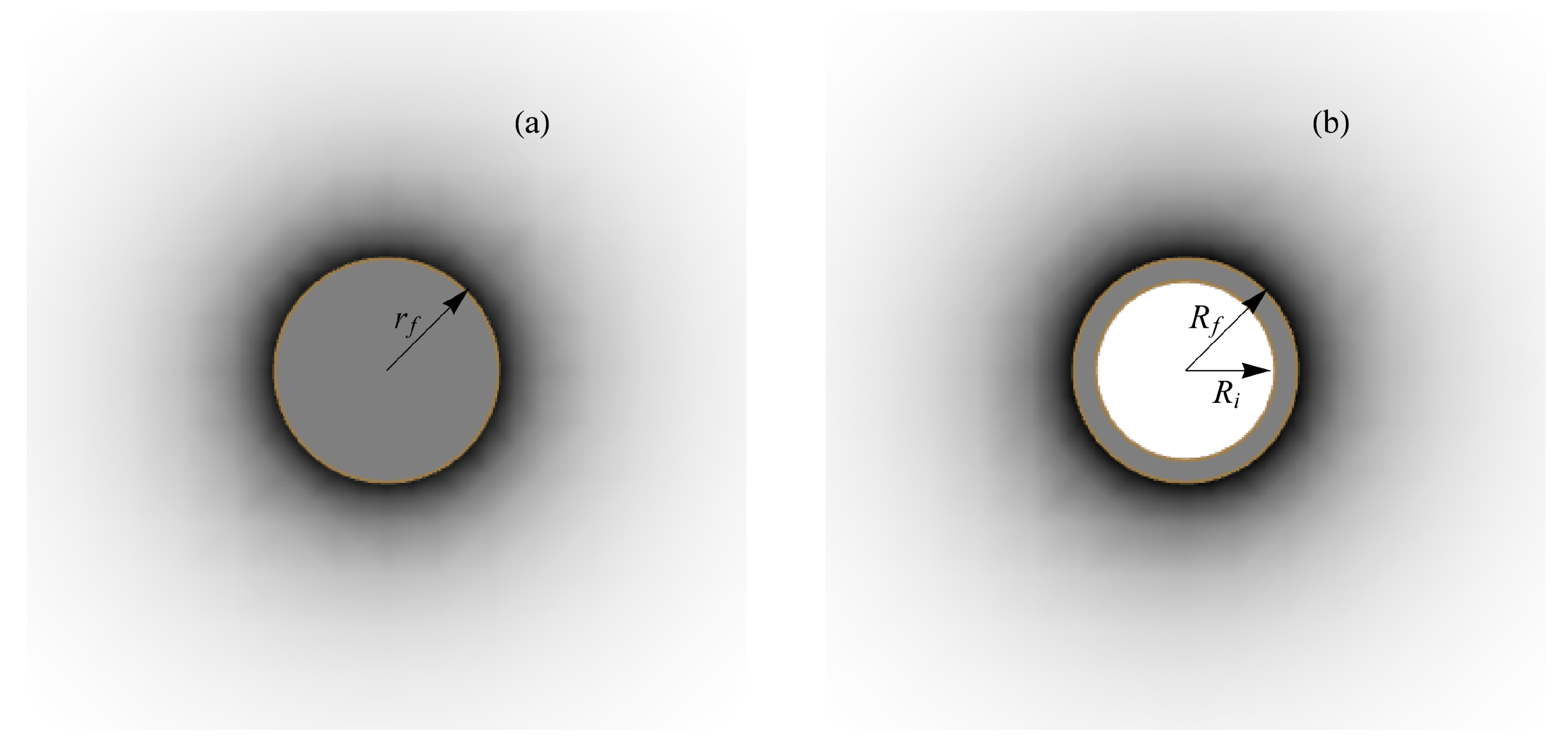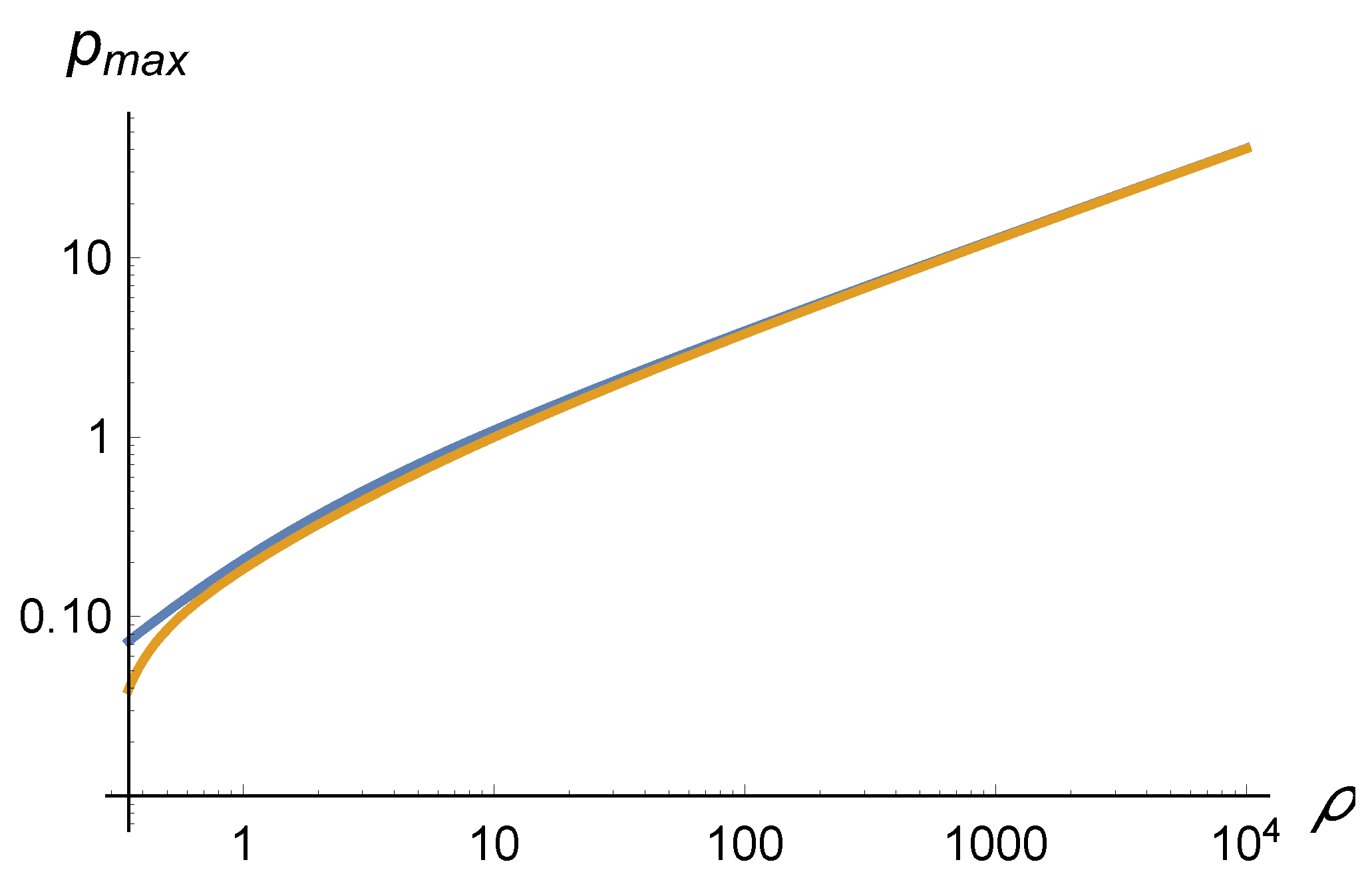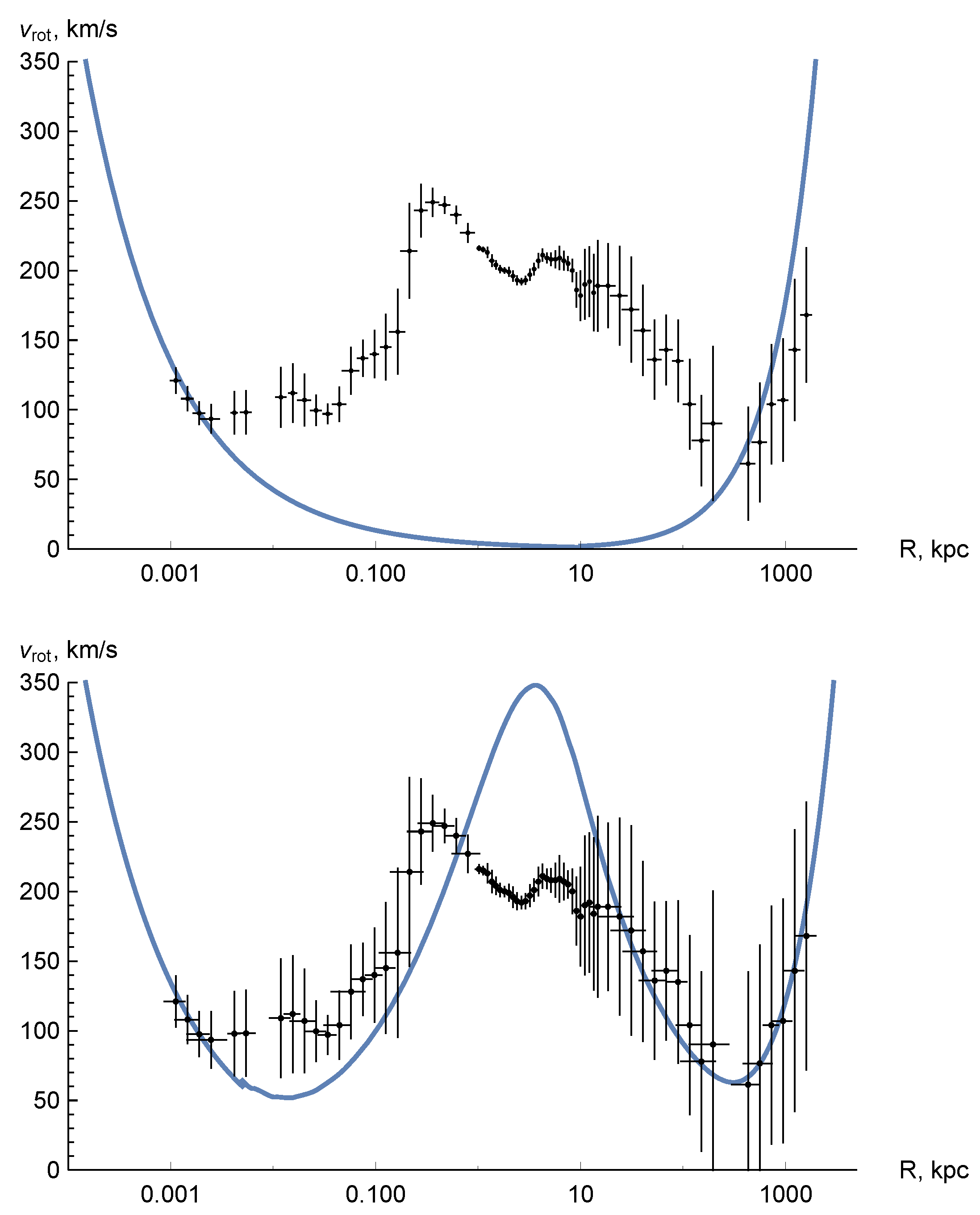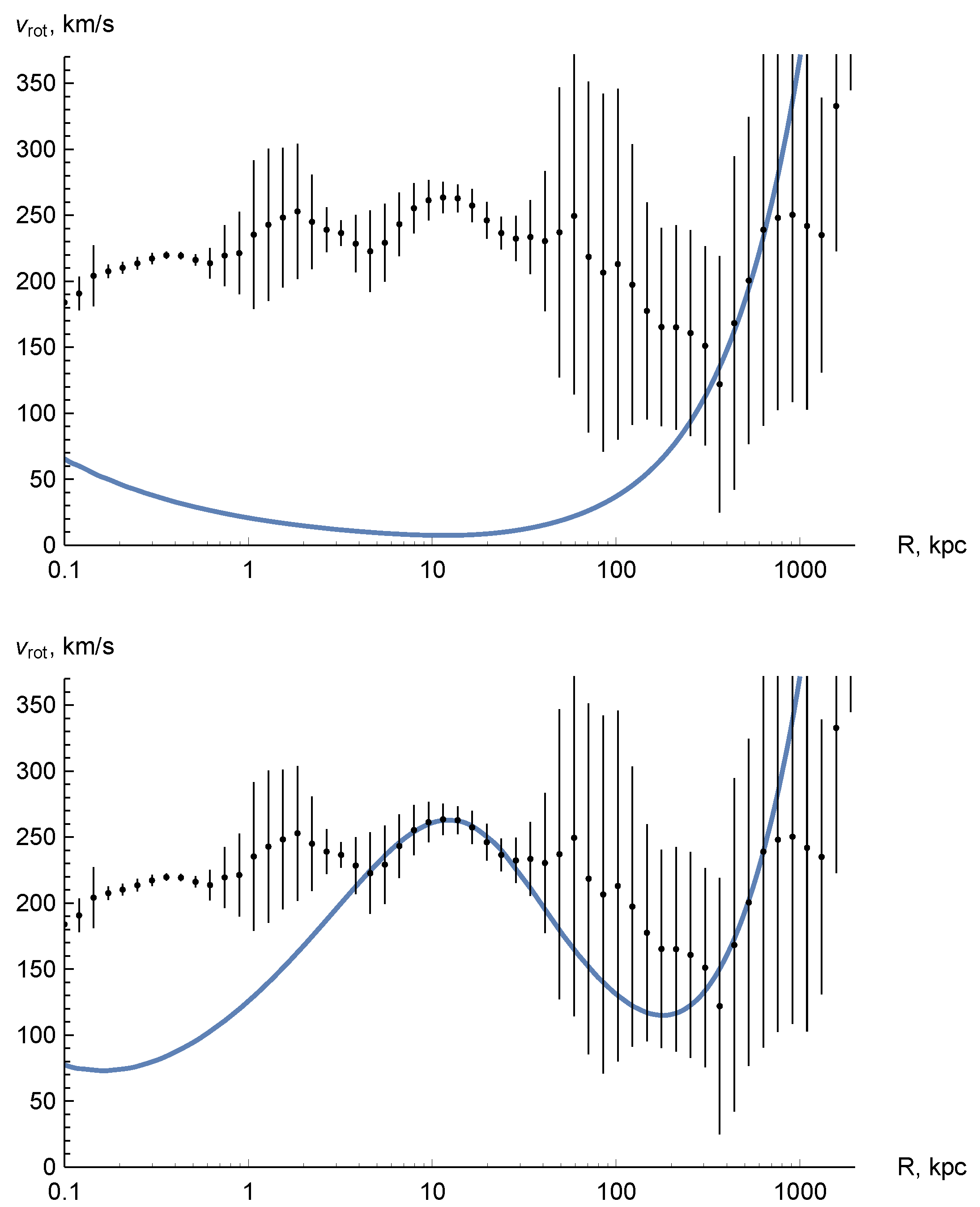Submitted:
28 July 2023
Posted:
16 August 2023
You are already at the latest version
Abstract
Keywords:
1. Introduction
2. What is “eicheon”?
3. Vacuum polarization around of eicheon
4. Andromeda
5. Discussion and conclusion
Appendix A. TOV equation for a mixture of ordinary and dark fluids
References
- Gillessen, S.; Eisenhauer, F.; Trippe, S.; others. Monitoring stellar orbits around the Massive Black Hole in the Galactic Center. Astrophys. J. 2009, 692, 1075–1109. [Google Scholar] [CrossRef]
- Nampalliwar, S.; Kumar, S.; Jusufi, K.; Wu, Q.; Jamil, M.; Salucci, P. Modeling the Sgr A* Black Hole Immersed in a Dark Matter Spike. Astrophys. J. 2021, 916, 116. [Google Scholar] [CrossRef]
- Abbott, R.; Abbott, T.; Acernese, F.; Ackley, K.; Adams, C.; Adhikari, N.; Adhikari, R.; Adya, V.; Affeldt, C.; Agarwal, D. others. GWTC-3: Compact Binary Coalescences Observed by LIGO and Virgo During the Second Part of the Third Observing Run, 2021. C: GWTC-3; arXiv:gr-qc/2111.03606.
- Akiyama, K.; Alberdi, A.; Alef, W.; Asada, K.; Azulay, R.; Baczko, A.K.; Ball, D.; Baloković, M.; Barrett, J.; Bintley, D.; others. First M87 event horizon telescope results. VI. The shadow and mass of the central black hole. Astrophys. J. Lett. 2019, 875, L6. [Google Scholar]
- Johnson, M.D.; Narayan, R.; Psaltis, D.; Blackburn, L.; Kovalev, Y.Y.; Gwinn, C.R.; Zhao, G.Y.; Bower, G.C.; Moran, J.M.; Kino, M.; others. The Scattering and Intrinsic Structure of Sagittarius A* at Radio Wavelengths. Astrophys. J. 2018, 865, 104. [Google Scholar] [CrossRef]
- Landau, L.D.; Lifshitz, E. The Classical Theory of Fields; Vol. 2, Butterworth-Heinemann: Oxford, 1975. [Google Scholar]
- Chandrasekhar, S. The mathematical theory of black holes; Oxford University Press: New York, USA, 1983. [Google Scholar]
- Cardoso, V.; Pani, P. Testing the nature of dark compact objects: a status report. Liv. Rev. Rel. 2019, 22, 1–104. [Google Scholar] [CrossRef]
- Berti, E.; Barausse, E.; Cardoso, V.; Gualtieri, L.; Pani, P.; Sperhake, U.; Stein, L.C.; Wex, N.; Yagi, K.; Baker, T.; others. Testing general relativity with present and future astrophysical observations. Class. Quant. Grav. 2015, 32, 243001. [Google Scholar]
- Yagi, K.; Stein, L.C. Black hole based tests of general relativity. Class. Quant. Grav. 2016, 33, 054001. [Google Scholar] [CrossRef]
- Logunov, A.A.; Mestvirishvili, M.A. On the possibility of gravitational collapse in the relativistic theory of gravity. Theor. Math. Phys. 1997, 112, 1056–1067. [Google Scholar] [CrossRef]
- Barceló, C.; Liberati, S.; Sonego, S.; Visser, M. Fate of gravitational collapse in semiclassical gravity. Phys. Rev. D 2008, 77, 044032. [Google Scholar] [CrossRef]
- Chapline, G. Emergent Space-Time. In Beyond Peaceful Coexistence: The Emergence of Space, Time and Quantum; Licata, I., Ed.; Imperial College Press: London, the UK, 2016; pp. 419–432. [Google Scholar]
- Carballo-Rubio, R.; Di Filippo, F.; Stefano Liberati, S.; Visser, M. A connection between regular black holes and horizonless ultracompact stars, 2022. 2022; arXiv:gr-qc/2211.05817. [Google Scholar]
- Carballo-Rubio, R.; Filippo, F.D.; Liberati, S.; Visser, M. Singularity-free gravitational collapse: From regular black holes to horizonless objects, 2023. F: gravitational collapse, 2023; arXiv:gr-qc/2302.00028. [Google Scholar]
- Schunck, F.E.; Mielke, E.W. General relativistic boson stars. Class. Quant. Grav. 2003, 20, R301. [Google Scholar] [CrossRef]
- Ray, S.; Sengupta, R.; Nimesh, H. Gravastar: An alternative to black hole. Int. J. Mod. Phys. D 2020, 29, 2030004. [Google Scholar] [CrossRef]
- Urbano, A.; Veermäe, H. On gravitational echoes from ultracompact exotic stars. JCAP 2019, 2019, 011. [Google Scholar] [CrossRef]
- Singh, K.N.; Ali, A.; Rahaman, F.; Nasri, S. Compact stars with exotic matter. Phys. Dark Universe 2020, 29, 100575. [Google Scholar] [CrossRef]
- Hayward, S.A. Formation and evaporation of nonsingular black holes. Phys. Rev. Lett. 2006, 96, 031103. [Google Scholar] [CrossRef] [PubMed]
- Frolov, V.P. Notes on nonsingular models of black holes. Phys. Rev. D 2016, 94, 104056. [Google Scholar] [CrossRef]
- Sofue, Y. Rotation Curve and Mass Distribution in the Galactic Center – From Black Hole to Entire Galaxy. Publ. Astron. Soc. Jpn. 2013, 65, 118. [Google Scholar] [CrossRef]
- Baes, M.; Buyle, P.; Hau, G.K.; Dejonghe, H. Observational evidence for a connection between supermassive black holes and dark matter haloes. MNRAS 2003, 341, L44–L48. [Google Scholar] [CrossRef]
- Dai, D.C.; Starkman, G.; Stojkovic, D. Milky Way and M31 rotation curves: ΛCDM versus MOND. Phys. Rev. D 2022, 105. [Google Scholar] [CrossRef]
- Chan, M.H.; Lee, C.M. Indirect evidence for dark matter density spikes around stellar-mass black holes. Astrophys. J. Lett. 2023, 943, L11. [Google Scholar] [CrossRef]
- Carr, B.; Kühnel, F. Primordial black holes as dark matter: recent developments. Ann. Rev. Nucl. Part. Sci. 2020, 70, 355–394. [Google Scholar] [CrossRef]
- Bertone, G.; Tait, T.M. A new era in the search for dark matter. Nature 2018, 562, 51–56. [Google Scholar] [CrossRef]
- Cherkas, S.L.; Kalashnikov, V.L. Vacuum Polarization Instead of Dark Matter in a Galaxy. Universe 2022, 8, 456. [Google Scholar] [CrossRef]
- Birrell, N.D.; Davis, P.C.W. Quantum Fields in Curved Space; Cambridge University Press: Cambridge, England, 1982. [Google Scholar]
- Brunetti, R.; Fredenhagen, K. Quantum Field Theory on Curved Backgrounds. In Quantum Field Theory on Curved Spacetimes: Concepts and Mathematical Foundations; Bär, C.; Fredenhagen, K., Eds.; Springer Berlin Heidelberg: Berlin, Heidelberg, 2009; pp. 129–155. [CrossRef]
- Cherkas, S.L.; Kalashnikov, V.L. Æther as an Inevitable Consequence of Quantum Gravity. Universe 2022, 8, 626. [Google Scholar] [CrossRef]
- Cherkas, S.L.; Kalashnikov, V.L. Eicheons instead of Black holes. Phys. Scr. 2020, 95, 085009. [Google Scholar] [CrossRef]
- Cherkas, S.L.; Kalashnikov, V.L. Structure of the compact astrophysical objects in the conformally-unimodular metric. J. Belarusian State Univ. Physics 2020, 3, 97–111. [Google Scholar] [CrossRef]
- Landau, L.D.; Lifshitz, E. Statistical Physics; Butterworth-Heinemann: Oxford, United Kingdom, 1980. [Google Scholar]
- Weidemann, V. White dwarfs. Ann. Rev. Astron. Astrophys. 1968, 6, 351–372. [Google Scholar] [CrossRef]
- Buchdahl, H.A. General Relativistic Fluid Spheres. Phys. Rev. 1959, 116, 1027–1034. [Google Scholar] [CrossRef]
- Weinberg, S. Gravitation and Cosmology: Principles and Applications of the General Theory of Relativity; John Wiley & Sons: New York, 1972. [Google Scholar]
- Kormendy, J.; Bender, R. The Double Nucleus and Central Black Hole of M31. Astrophys. J. 1999, 522, 772–792. [Google Scholar] [CrossRef]
- Bender, R.; Kormendy, J.; Bower, G. ; others. HSTSTIS Spectroscopy of the Triple Nucleus of M31: Two Nested Disks in Keplerian Rotation around a Supermassive Black Hole. Astrophys. J. 2005, 631, 280–300. [Google Scholar] [CrossRef]
- Sofue, Y. Dark halos of M 31 and the Milky Way. Publ. Astron. Soc. Japan 2015, 67, 75. [Google Scholar] [CrossRef]
- Haridasu, B.S.; Cherkas, S.L.; Kalashnikov, V.L. A reference level of the Universe vacuum energy density and the astrophysical data. Fortschr. Phys. 2020, 68, 2000047–1912. [Google Scholar] [CrossRef]
| 1 |



Disclaimer/Publisher’s Note: The statements, opinions and data contained in all publications are solely those of the individual author(s) and contributor(s) and not of MDPI and/or the editor(s). MDPI and/or the editor(s) disclaim responsibility for any injury to people or property resulting from any ideas, methods, instructions or products referred to in the content. |
© 2023 by the authors. Licensee MDPI, Basel, Switzerland. This article is an open access article distributed under the terms and conditions of the Creative Commons Attribution (CC BY) license (http://creativecommons.org/licenses/by/4.0/).




